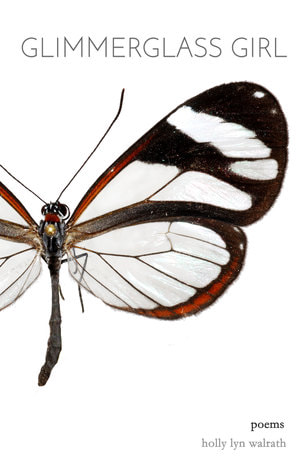|
Glimmerglass Girl by Holly Lyn Walrath (Finishing Line Press, 2018)
When others see me, they will see a woman unhinged. I will crawl out of my skin, leaving it all heaped behind me and the naked me will walk home alone in the darkness a disciple of shadows, an acolyte of the moon. (from “I am Going to Find the Unicorns”) The chapbook Glimmerglass Girl, while a whorl of selected moments, contains a collective and collective energy that has the potential to awe and influence. It is a feminist work as much as it is a work of an independent, confident poet. There is a general outburst of energy here, one that indicates journey and trial and achievement. It is a landscape of learning and knowledge, wisdom even, attained through the process of living out womanhood. These are poems that, as a collection, field experiential memory and meditative spaces of raw emotion. The book, both narrative and lyrical, lends itself to a harmony of reflection and gracious internalization. The poems are short and brief, and ultimately find their strongest qualities through Holly Lyn Walrath’s overarching voice when the book has been read and the covers finally closed. Following a brief preface, “On Womanhood,” which requests the reader tread softly through the book’s pages, Glimmerglass Girl displays its 24 poems in a manner of delicate, slow care. “in the night glass is everywhere” opens the poetry of Walrath’s collection, indicating that delicateness is already present. The poem “Espejitos,” (“little mirror” in Spanish) sets not only the quality of the poet’s mental and emotional approach to her life and livelihood, but also sets the motif that will return from piece to piece. The glass/mirror metaphor is not only in the imagery of the poems, but in the voices Walrath brings to the work, and, curiously, in the muse buried behind the history of each poem. Not only do previous circumstances serve for fuel of this poetry’s illumination, but previous aspects and iterations of the core self. These poems are architectural to the identity of the poet and even indicate a degree of transformation and transposition. The book indicates the poet’s cautious and unparalleled journey to get from previous to current states of being. And, remarkably, the metaphor never needs to be broken to reflect or scatter (open) those moments of illumination. The delicacy remains. Her hands are soft and diminishing, becoming like the petals of the peony or lace paper—gold leaf. (from “Peony Red”) Glass is not the only surface or material that is operating within Glimmerglass Girl. Gold, another delicate substance, which carries symbolic properties, including the regal and the beautiful, appears multiple times throughout the book. There is a consistent sense of questioning when gold shows up, nearly alchemical in its positioning: what does this metallic serve as ingredient to? How does Walrath use it to position her own sense of self? Is it preservation of beauty? Is it a subconscious protection of identity? Is it merely the ornate, supplemental beauty that we all wish to carry around with us from time to time? Or perhaps it is purer, more abstract at its heart. Details like gold, skin, weather, and other elemental imagery appear and disappear in a morphic process both ritualistic and organic the same. As such, Walrath has composed these vignettes with the capacity for explicit definition, but there is diffusion, abstraction, a termed fizzling. It is a world of memory and the temporary. Creating these premises allow for Walrath’s firm, pronounced independence to shine. And as a result, her voices open and chisel across the page with distinction and confidence. The book’s textual poetry is combined with images pulled from archives and reused in new contexts here. How they play out, typically sharing space on the page with the poems, is typically straightforward and strong. However, while Walrath’s work in Glimmerglass Girl is fantastically capable and certain, it is curious to see that several poems positioned on the page overlap or are placed above the images. In numerous instances, this makes the poetry very difficult to physically read. While Finishing Line Press has created an engaging, explorative book, these design constraints unfortunately keep at least two of the poems from full physical readability/legibility. And while it would be fine to ignore these qualities directly, there is value to them! The obfuscation here elevates and makes even more obvious the severity of the book’s original motif: the glass and the mirrors, and their resulting effects on light and clarity. The conflict with the embedded pictures results in its own conversation on how we find meaning and truth when integrating the external world with our own, purest forms of communication and expression. Whether intentional or not, there is a benefit in the selected images. I am night and a thousand stars hurtle through my skin, punching through the ether. I crouch, prehistoric, in the space behind clouds, my volcanic heart attracting lightning, sympathetic interstellar. (from “Anvil Crawler”) Reading from cover to cover, this short collection of poems resonates deeply. As a male reader, I found the book to be filled with insight, information, and inspiration for knowing more about the female experience. I imagine the feminist offerings this book undoubtedly can provide to female readers will create realms of influence and inspiration in other, exciting ways. The individualism and independence of Walrath’s voice, and her movement from pillar of experience to pillar of experience, and beyond, has set a precedent for even more of her work. What it will bring, and how Walrath will view herself and the world around her, is an exciting and encouraging prospect.
0 Comments
Your comment will be posted after it is approved.
Leave a Reply. |
Welcome to Yellow Rabbits. Thanks for visiting.
All reviews by Greg Bem unless marked otherwise.
SearchYellow Rabbits Reviews
Archives by Month
August 2019
|

